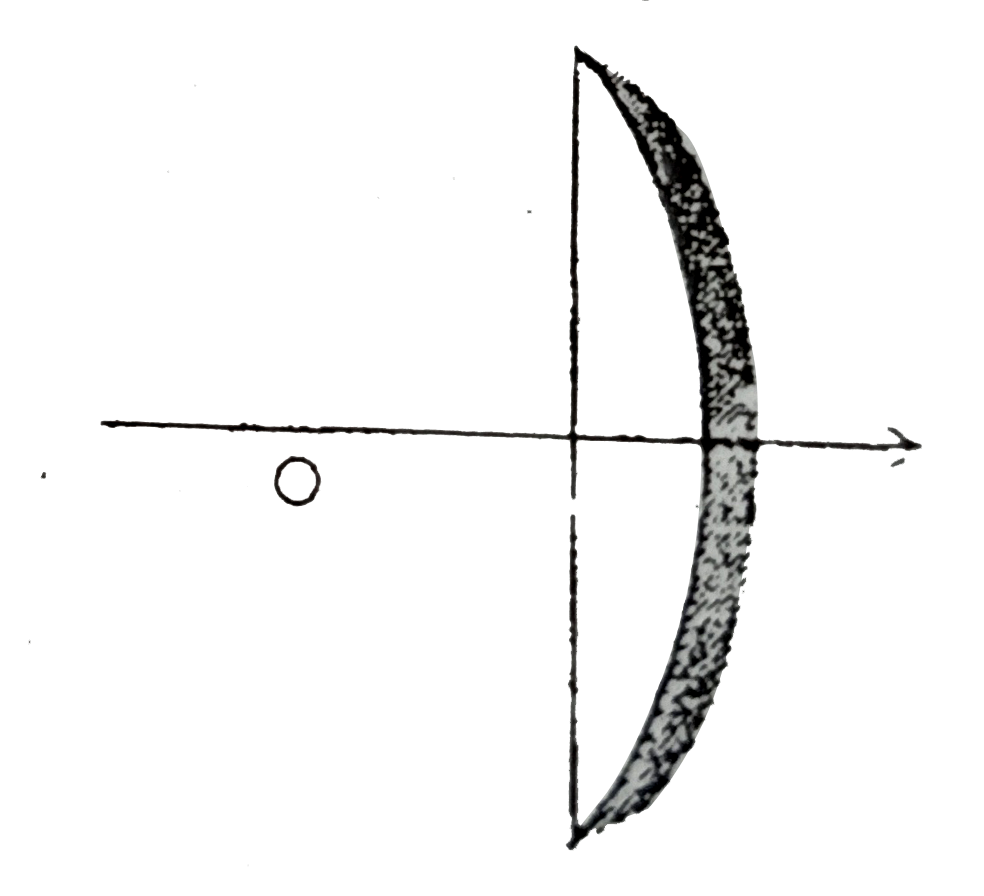A plano convex lens of refractive index 1.5 and radius of curvature 30cm. Is silvered at the curved surface. Now this lens has been used to form the image of an object. At what distance from this lens an object be placed in order to have a real image of size of the object.
tan−1(t1t2)
sin−1(t1t2)
sin−1(10t1t2)
tan−1(10t1t2)
The correct Answer is:A
To solve the problem step by step, we will follow these instructions:
Step 1: Calculate the Focal Length of the Plano-Convex Lens
The formula for the focal length f1 of a plano-convex lens is given by:
1f1=(μ−1)(1R1−1R2)
Where:
- μ is the refractive index of the lens (1.5).
- R1 is the radius of curvature of the first surface (infinity for plano surface).
- R2 is the radius of curvature of the second surface (30 cm, which is taken as -30 cm because it is a convex surface).
Substituting the values:
1f1=(1.5−1)(1∞−1−30)
This simplifies to:
1f1=0.5(0+130)=0.530=160
Thus,
f1=60 cm
Step 2: Determine the Focal Length of the Silvered Surface
Since the lens is silvered at the curved surface, it behaves like a concave mirror. The focal length fm of a concave mirror is given by:
fm=−R2
Where R is the radius of curvature (30 cm).
Thus,
fm=−302=−15 cm
Step 3: Calculate the Equivalent Focal Length
The equivalent focal length feq of the system (lens + mirror) can be calculated using the formula:
1feq=1f1+1fm
Substituting the values we found:
1feq=160+1−15
Finding a common denominator (which is 60):
1feq=160−460=−360=−120
Thus,
feq=−20 cm
Step 4: Determine the Object Distance for a Real Image of Same Size
For a real image of the same size as the object, the object distance u must be equal to twice the focal length:
u=2feq
Substituting the value of feq:
u=2×(−20)=−40 cm
Since the object distance is conventionally taken as positive in the direction of the incoming light, we take the absolute value:
u=40 cm
Final Answer
The object should be placed at a distance of 40 cm from the lens to form a real image of the same size as the object.
---
- μ is the refractive index of the lens (1.5).
- R1 is the radius of curvature of the first surface (infinity for plano surface).
- R2 is the radius of curvature of the second surface (30 cm, which is taken as -30 cm because it is a convex surface).
Topper's Solved these Questions
- RAY OPTICSBOOK - DC PANDEY ENGLISHCHAPTER - RAY OPTICSEXERCISE - medical entrance special format question
23 Videos
- RAY OPTICSBOOK - DC PANDEY ENGLISHCHAPTER - RAY OPTICSEXERCISE - Medical entrance gallary
76 Videos
- RAY OPTICSBOOK - DC PANDEY ENGLISHCHAPTER - RAY OPTICSEXERCISE - Checkpoint 9.7
10 Videos
- NUCLEIBOOK - DC PANDEY ENGLISHCHAPTER - NUCLEIEXERCISE - C MADICAL ENTRANCES GALLERY
46 Videos
- REFLECTION OF LIGHTBOOK - DC PANDEY ENGLISHCHAPTER - REFLECTION OF LIGHTEXERCISE - Subjective
9 Videos
Similar Questions
A plano-convex lens has refractive index 1.6 and radius of curvature 60 cm. What is the focal length of the lens?
View SolutionWhere should an object be placed in front of a convex lens to get a real to get real image of the size of the object ?
View SolutionA plano-covex lens is made of a material of refractive index n. When a small object is placed 30cm away in front of the curved surface of the lens, an image of double the size of the object is produced. Due to reflection from the convex surface of the lens, another faint image is observed at a distance of 10 cm away from the lens. Which of the following statement (s) is (are) true?
View SolutionA thin biconvex lens of refractive index 3/2 and radius of curvature 50cm is placed on a reflecting convex surface of radius of curvature 100cm. A point object is placed on the principal axis of the system such that its final image coincides with itself. Now, few drops of a transparent liquid is placed between the mirror and lens such that final image of the object is at infinity. Find refractive index of the liquid used. Also, find the position of the object.
View SolutionA point object is placed in front of a silvered plano convex lens of refractive index n radius of curvature R, so that its image is formed on itself. Then the object distance is equal to

View SolutionA luminous object is placed at a distance of 30 cm. from the convex lens of focal length 20 cm. On the other side of the lens, at what distance from the lens, a convex mirror of radius of curvature 10 cm. be placed in order to have an upright image of the object coincident with it ?
View SolutionAn object in placed 30cm in front of a concave lens that is made of a glass of refractive index 1.5 and has equal radii of curvature of its two surfaces, each 30 cm. The surface of the lens farther away from the object is silvered. Find the nature and position of the final image.
View SolutionA convex lens produces a double size real image when an object is placed at a distance of 18 cm from it. Where should the object be placed to produce a triple size real image ?
View SolutionThe redius of curvature of the convex face of a plano-convex lens is 12cm and its refractive index is 1.5.
a. Find the focal length of this lens. The plane surface of the lens is now silvered.
b. At what distance form the lans will parallel rays incident on the convex face converge?
c. Sketch the ray diagram to locate the image, when a point object is places on the axis 20cm from the lens.
d. Calculate the image distance when the object is placed as in (c).
View SolutionA convex lens produces a real image m times the size of the object. What will be the distance of the object from the lens ?
View Solution